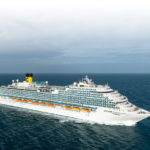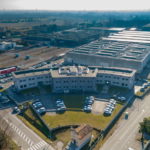To guarantee efficient shipbuilding at cruise shipyards, logistics for interior design is key. Fincantieri group relies on its own production affiliate and combines land-based and maritime transport, writes Michael Meyer
The 100% subsidiary »Marine Interiors« was established in 2014 to enable the group, whose cruise ship newbuilding facilities are located[ds_preview] predominantly in Italy and through its subsidiary Vard in Norway, to integrate cabin design and production into its design and construction flow.
German competitor Meyer Werft is well-known for its »blockbuilding construction« with prefabricated hull sections as well as for its longstanding and deep cooperation with a huge number of regional suppliers. The shipyard group MV Werften which is also located in Germany has gone its own way, too, when setting up a cabin production facility in 2016. As completely pre-assembled modules, the cabins are delivered to the yards and installed there.
At Fincantieri, Marine Interiors focuses on designing, refitting and delivering turnkey cabins, in the fields of both newbuilding and refurbishment. The factory for interiors is located in Pordenone between the shipyards in Monfalcone and Marghera.
Logistical mix
Speaking to HANSA, Gabriele Cafaro, CEO of Marine Interiors, calls the business structure a »mix« of own production and the integration of suppliers in the supply chain. »In our four years period, we have changed and increased the product portfolio. We started from the cabins, building bulk heads and ceilings, and from the wet units. Since 2016 we are also taking care of the public areas, meaning restaurants, theatres, atriums, spa, fairs.« Eventually, Fincantieri set up a new company with private shareholders for industrial kitchens. Especially for the expedition cruise vessels being built in Norway, the team takes care of the entire accommodation. When it comes to aspects like glazing, catering, laundry and provisions, Marine Interiors is kind of an intermediate coordinating the supply chain between the suppliers and shipyards.
In the cabin segment, kits are sent to the yards where they are prefabricated and put inside the vessels. The bathroom modules are already prefabricated at the MI-factory. However, it is completely different for the »public areas«, as Cafaro explains: »We do not have our own production. We have a system of subcontractors for furniture, lighting and other decorative elements that are changing a lot. This choice has been done for the scale, because as much as you have an industrial product such as cabins and bathroom, it is more convenient to establish a factory and send as much as you can prefabricated on the yard.« Because public areas vary a lot, not least following architectural trends. »In this segment, you need to be flexible, therefore it is hard to establish a mass production«, the CEO states.
»Made in Italy«
According to Cafaro, MI is responsible for 90% of the cabins that Fincantieri is using, as well as for 30 to 40% of public areas.
As it is with Papenburg-based Meyer Werft, Fincantieri relies on a network of regional and national suppliers, too, in case MI is not producing itself. 90% of the suppliers are located in Italy. Cafaro does not hide the fact that this structure can result in additional costs compared to suppliers from other regions. However, there is a certain commitment to the initiative »Made in Italy«. The sheer mass brings advantages in this respect, Cafaro says: »We have a long-lasting backlog, so we can leverage on our scale to obtain a »Made in Italy« quality at a reasonable price.«
From the factory, by far the largest share of kits and modules are transported in containers on the road to the shipyards. In terms of the logistic chain to the Norwegian sites, it is around 90%. The rest is done either by the cruise vessels themselves when shifting from one production facility to the yard of final outfitting or sometimes with smaller container vessels.
Special attention to China
The likewise growing and complex market China is a very special case – for the whole cruise industry and Fincantieri, respectively. The Italians are active with a joint venture (see box) and want to participate in the boom of the local cruise industry. In February, Fincantieri delivered the first vessels designed especially for the Asian market, the »Costa Venezia«.
It was like entering a new market. »Everything goes down to what the ship is for. It is completely different to entertain a Chinese. Even the distribution of public areas is completely different. You have more gaming areas, different restaurants, different open spaces«, the CEO emphasizes. In the medium term, the joint venture intends to build ships in China with China-based suppliers. Cafaro says, MI will be active there: »We will and we are already structuring a team and the facilities to be serving the vessels being built there.« Until then, the Italians will deliver their interior products to the Far East.
For the first vessels, the logistical process will be a careful mix, »we will need to be on the safe side to secure the supply chain«, what can be a headache, the CEO adds. So in the beginning, the modules will be shipped by vessels from Europe to China. »But of course, when the market goes up and more vessels will be built here, we will be more and more establishing a stance in China.«
More growth potential
Besides the geographical aspects, Cafaro has more growth potential in mind. First, there is the interior market itself, in which MI would like to add further products to its portfolio. »We are looking carefully to the development of a plan for galleys. In terms of production, what we can change is to increase the production of the panels also for the wet units and not only for the cabins. Then we are looking around to grow our group with adjacent business, such as glazing, which could be interesting for us«, he summarizes. Second, the management sees a growing demand for the refurbishment of older cruise tonnage. An increasing number of clients ask for a corresponding service, as new regulation comes into force, passengers ask for modern equipment and the market is still booming. »We want to grow in this industry as well«, Cafaro says with a glimpse beyond existing structures, »even if the vessels were not built by Fincantieri, originally.«
Michael Meyer


















